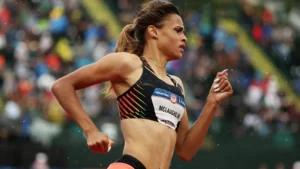Sydney McLaughlin-Levrone, a name that now echoes greatness, began her Olympic journey at an age when most of us were figuring out high school life. At just 16, she stepped onto the global stage in the 400-meter hurdles. She was technically still a kid, yet she was racing against the best in the world. The road to Rio was nothing short of jaw-dropping. During the 2016 U.S. Olympic Trials, Sydney clocked a mind-blowing 54.15 seconds, breaking the world youth best and junior record while securing her ticket to the Olympics. Let’s not forget that she was still balancing homework with hurdles, and her epic sprint made her the youngest U.S. Olympic track and field athlete since 1980. But Rio wasn’t all gold and glory. When it came time to race, Sydney placed fifth in her semi-final heat, missing the finals. It was a lot to handle for someone who’d just been thrown into the limelight. And now she has opened up about how overwhelming the pressure felt, recalling how she would literally run away from the media leading up to the Olympics. Can you blame her? At 16, most of us were running away from awkward school pictures, not the weight of international expectations!
In Far Beyond Gold, Sydney McLaughlin-Levrone shared the behind-the-scenes parts of her story. “I had dozens of stories like that,” she said, describing episodes of acute concern—she was afraid to disobey her parents, anger God, or look foolish. Reflecting on the aftermath of the Olympic trials, she admitted, “Those memories and the apprehension they represented were with me. And they were a huge but unseen part of my story that summer.”

As the world watched her non-emotional, unbreakable forte, Sydney felt the pressure to fit into the narrative the media wanted to tell. “Suddenly, my childhood was of interest to a lot of people,” she wrote. “There was an assumption that I was built differently. The media loves to feed narratives like this. It’s good for business.” Journalists were interested in the ways she worked on her competitive advantage and desire to succeed. “They are looking for the ingredients of an athlete’s success—the experience, lessons, obstacles, and influences that molded them into an Olympic athlete,” she explained. “They want to craft a narrative, tell a story about an underdog overcoming adversity or a talented prodigy not buckling under the weight of expectations.” But Sydney realized that her tale did not belong to the triumphant genre of women who fought against the impossible—it was a blessing. “I didn’t earn it; I just had it. It was as much a part of me as my height and brown eyes,” she shared. This was evident even at six years old; Sydney was able to race for the first time in her life. Scared of losing, she pleaded with her dad not to make her run. But his simple reassurance, “Sydney, you can do this. You were made to do this,” was enough to make me feel better—and win. And Sydney’s dad has been there for her every step of the way.
